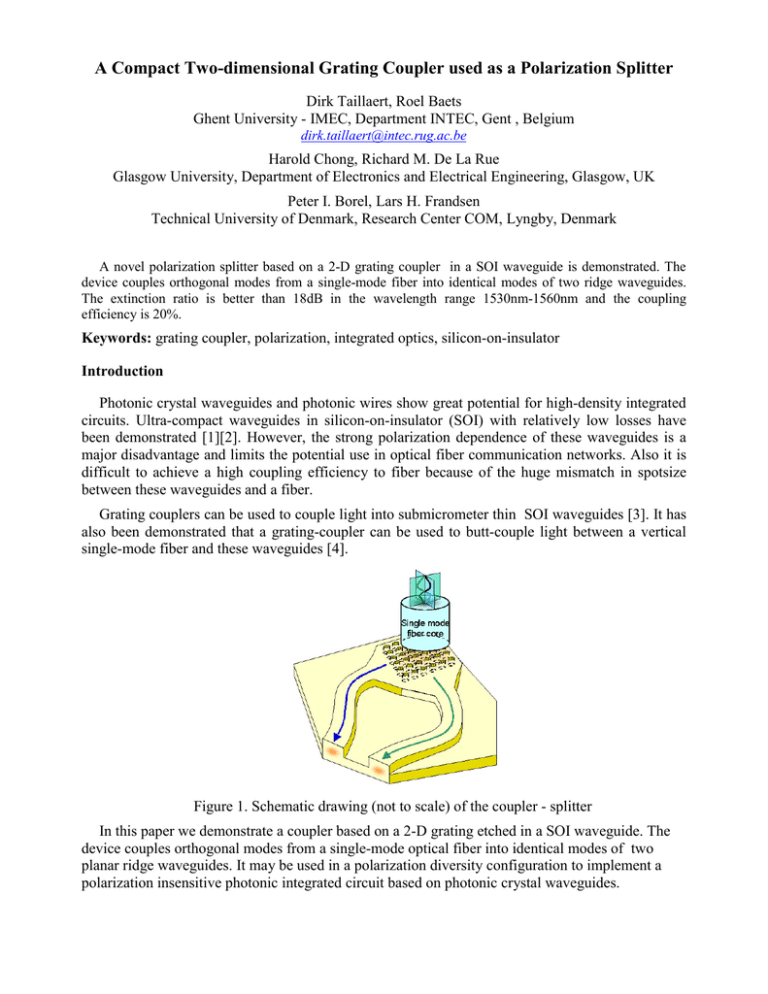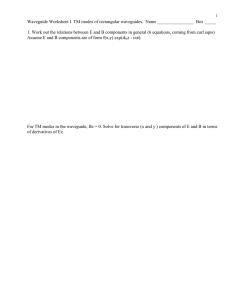A Compact Two-dimensional Grating Coupler used as a Polarization
advertisement

A Compact Two-dimensional Grating Coupler used as a Polarization Splitter Dirk Taillaert, Roel Baets Ghent University - IMEC, Department INTEC, Gent , Belgium dirk.taillaert@intec.rug.ac.be Harold Chong, Richard M. De La Rue Glasgow University, Department of Electronics and Electrical Engineering, Glasgow, UK Peter I. Borel, Lars H. Frandsen Technical University of Denmark, Research Center COM, Lyngby, Denmark A novel polarization splitter based on a 2-D grating coupler in a SOI waveguide is demonstrated. The device couples orthogonal modes from a single-mode fiber into identical modes of two ridge waveguides. The extinction ratio is better than 18dB in the wavelength range 1530nm-1560nm and the coupling efficiency is 20%. Keywords: grating coupler, polarization, integrated optics, silicon-on-insulator Introduction Photonic crystal waveguides and photonic wires show great potential for high-density integrated circuits. Ultra-compact waveguides in silicon-on-insulator (SOI) with relatively low losses have been demonstrated [1][2]. However, the strong polarization dependence of these waveguides is a major disadvantage and limits the potential use in optical fiber communication networks. Also it is difficult to achieve a high coupling efficiency to fiber because of the huge mismatch in spotsize between these waveguides and a fiber. Grating couplers can be used to couple light into submicrometer thin SOI waveguides [3]. It has also been demonstrated that a grating-coupler can be used to butt-couple light between a vertical single-mode fiber and these waveguides [4]. Figure 1. Schematic drawing (not to scale) of the coupler - splitter In this paper we demonstrate a coupler based on a 2-D grating etched in a SOI waveguide. The device couples orthogonal modes from a single-mode optical fiber into identical modes of two planar ridge waveguides. It may be used in a polarization diversity configuration to implement a polarization insensitive photonic integrated circuit based on photonic crystal waveguides. Concept Consider a grating coupler consisting of a 2-D grating etched in a single ridge waveguide. In general the coupling efficiency from fiber to waveguide is polarization dependent. For the waveguides and gratings we use, the coupling efficiency for TE is much larger than the coupling efficiency for TM. The coupling from fiber to waveguide 1 will be maximum if the input is linearly polarized in the y direction. Figure 2. Top view of the splitter structure The structure of fig. 2 consists of 2 ridge waveguides that are orthogonal. The 2-D grating is etched into the crossing of the waveguides and is invariant for a 90 degree rotation. The linear polarization with electric field Ey will couple to waveguide 1 and the other polarization with electric field Ex to waveguide 2. In general, eliptically polarized light from a single mode fiber will couple both to waveguide 1 and 2. The coupling ratio will depend on the state of polarization, but the coupling to wg1 and wg2 together will be independent of it. The 90 degree bend in waveguide 2 is only used for practical reasons (to have the 2 outputs at the same cleaved facet). We have described the working principle as input coupler, but the device can also be used as output coupler. There is a very important difference between conventional polarization splitters described in literature [5] and our splitter. In a conventional splitter, the input light is splitted in a TE and TM waveguide mode. In our device, the light from a fiber is splitted in two TE waveguide modes. Because in the two waveguides the same polarization (TE) is used, the device can be usefull to make polarization insensitive photonic integrated circuits, using waveguides which are very strongly polarization sensitive. Experimental results The structures were fabricated on SOI wafers with a top silicon film thickness of 220nm and a buried SiO2 layer thickness of 1µm. Gratings and waveguides were defined using electron beam lithography and reactive ion etching. A top view is shown in figure 3. The grating is a square array of holes, the etch depth is 90nm and the lattice period 580nm. The hole diameter is 300nm. The ridge waveguides are 10µm wide. A 90 degree bend is inserted in one of the waveguides to be able to detect both ouputs at one cleaved facet. Figure 3. SEM top view We used the structures from fig. 2 to measure the extinction ratio and check the polarization of the light in the waveguides. A vertical fiber couples light from a tunable laser into the waveguides via the grating. We detect the output power of waveguides 1 and 2 at the cleaved facet using a 40x objective and a power detector. After the initial alignment, the position of the fiber is fixed and only the polarization and wavelength are changed during the further measurements. The polarization of the input light is changed using a Lefevre type polarization controller to maximize output 1 or ouput 2. Then the extinction ratio between the 2 outputs is measured for both cases. The extinction ratio is shown in fig. 4a for different wavelengths. The extinction ratio is better than 18dB in the wavelength range 1530-1560nm. The difference between the 2 cases is caused by radiation losses in the 90 degree bend in waveguide 2. We have also verified the polarization of the light in the waveguides. The ouput power versus wavelength for the case when output 1 is maximised is shown in fig. 4b. The fringes in these curves are caused by a cavity between the grating and a cleaved facet. 30 2/1 20 15 10 5 output 1 output 2 0.05 output power (mW) extinction ratio (dB) 25 0.04 0.03 0.02 0.01 0 1500 0.06 1/2 1520 1540 1560 1580 1600 wavelength (nm) Figure 4a. Extinction ratio measurement 0 1500 1520 1540 1560 1580 wavelength (nm) 4b. Output power versus wavelength 1600 It is not straightforward to determine the coupling efficiency from the power detected at the cleaved facet because of the facet reflectivity and the high numerical aperture of the waveguides. Therefore we estimate the coupling efficiency from a transmission measurement from fiber to waveguide to fiber on a structure consisting of a waveguide with a grating coupler at both ends. In this measurement, the fibers are tilted slightly to shift the wavelength out of the second order grating reflection peak and thus avoid cavity effects between the two gratings. The fiber to fiber transmission is 4% for TE-polarization, so the coupling efficiency is 20% if we take into account that the coupling from fiber to waveguide is the same as from waveguide to fiber. Summary We have demonstrated a polarization splitter based on a 2-D grating etched in a SOI waveguide. The device couples light from a single-mode optical fiber into two identical planar ridge waveguides. The extinction ratio is better than 18 dB in the wavelength range 1530-1560nm and the coupling efficiency is approximately 20%. The device is very compact and couples light only to TE-modes of the planar waveguides. Therefore, it may be used in a polarization diversity configuration to implement a polarization insensitive photonic integrated circuit based on photonic crystal waveguides. Acknowledgements This work was supported in part by the European Union in the context of the IST project PICCO and by the Belgian government in the context of the IAP PHOTON project. References [1] M. Notomi, A. Shinya, K. Yamada, J. Takahashi, C. Takahashi, I. Yokohama, IEEE J. Quantum Electron., vol. 38, 736-742, 2002 [2] K.L. Lee, D.R. Lim, L.C. Kimerling, J. Shin, F. Cerrina, Opt. Lett., vol. 26, 1888-1890, 2001 [3] R.M. Emmons, D.G. Hall, IEEE J. Quantum Electron., vol. 28., 164-175, 1992 [4] D. Taillaert, W. Bogaerts, P. Bienstman, T.F. Krauss, P. Van Daele, I. Moerman, S. Verstuyft, K. De Mesel, R. Baets , IEEE J. Quantum Electron., vol. 38, 949-955, 2002 [5] J. Van der Tol, J.W. Pedersen, E.G. Metaal, J. Van Gaalen, Y.S. Oei, F.H. Groen, IEEE Photonics Tech. Lett., vol.9, 209-211, 1997





